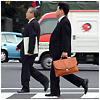
Men net fishing off of Tashiro-jima island.
Photo from Look Japan.Photo by Morita Yoned, Noanoa.
What Kinds of Work Do People Do in Japan?
The number of people in the Japanese labor force increased steadily from 36 million workers 1950 to 64 million in 1995, and then began to decline slightly. Over that time the nature of work has changed considerably. In 1950, nearly half (48.5%) of the labor force was engaged in farming, forestry, or fishing, which is called the primary sector. One fifth of the labor force (21.8%) was working in mining, construction, or manufacturing industries—the secondary sector. Nearly 30 percent (29.6%) was employed in various service industries, the tertiary [third]sector. The proportion of workers in the primary sector has dropped tremendously in the past 50 years, and by 2000 only 5% of the Japanese labor force was working in the primary sector. The secondary sector grew to nearly three in ten workers by 2000 (29.5%). The biggest growth was in the service or tertiary sector, which now employs about two-thirds (64.3%) of all workers.
|

